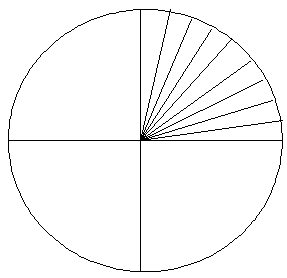Quarter-Sawing Technique
Other Versions
Spanish
What's the best way to quarter-saw a sycamore log? April 10, 2005
Question
I have a customer who wants quarter sawn sycamore. Does every board have to be true quartered for the figure to show, or will the traditional methods of quarter sawing produce good results? As I understand, sycamore, unless quarter sawn, will warp excessively. Do I have to saw every piece into a wedge shape like the picture, then resaw every board flat?

Forum Responses
(Sawing and Drying Forum)
From contributor G:
I don't think that's a good way to quarter saw any log. There are several different methods, but the one in your drawing is not one that I've ever seen. There is a lot of information in the Knowledge Base concerning quartersawing.
From the original questioner:
My question isn't on quartersawing in general, but is about sycamore, and from what I have read it must be true quartered to remain stable. If you saw with any of the traditional quartersawing methods, you are still only going to get maybe 8 true quarter sawn boards, right?
From contributor B:
To get the wild ray action in sycamore, you do need to be real close to QS, closer than getting a pattern in oak. If you're worried about stability only, it sounds as if you're afraid anything less than true QS will go to absolute garbage. That's not the case. I know plenty of people who use flat sawn stock. It is a little more unstable than some woods but certainly not useless. If you do wish to get more QS, once you have removed the true QS from each quarter and are down to rift sawn pie wedges, clamp these wedges at a 45 degree angle and saw through them. I built a jig to hold them during the first cut. This is slower and decreases yield, but gives more QS instead of rift sawn.
From Professor Gene Wengert, forum technical advisor:
With respect to q-sawn sycamore, the pattern you showed, which is a slight variation of a commonly used pattern, is fine. Let me suggest a variation, however. Saw the logs into quarters. Then saw once piece of the fresh face and then saw a second piece off of the other fresh face. Go back and forth from face to face. You will have essentially 100% q-sawn, although the width decreases with each piece cut. Hence, it is suggested that you not q-saw this way except for logs over 20" in diameter. Another technique is shown in the archives here, but you will not find it to work so well with sycamore and a picky customer.
From contributor V:
Is this possible with a portable saw mill? If so, how? I have been looking at these recently online and can't seem to wrap my mind around how you would do this!
From contributor B:
What I do is center the heart and take a very small slab off the top, rotate the log 90 degrees, recenter the heart, thin slab, rotate allowing the flat to rest on the bunks (the heart is now centered), thin slab, rotate and repeat so all sides have a very small flat on them.
Align your blade with the heart for reference, then raise up 2 to 21/2 boards, depending on whether your rings are still close to 90 degrees. Saw out the boards from the center. Set the top half in your cradle, remove the cut boards and stand the bottom up at 90 degrees. Using the same method, remove boards from the center.
You now have two pieces shaped like a baseball infield. Set one in the cradle and work with the other. If you're good with your clamping, you can balance the piece, but to start with you may want to make a jig to hold it at 45 degrees. Saw as much as you can before you hit your clamps or the jig, then turn it over and finish sawing through and through. Hope this made sense. It takes time but isn't really too hard. This requires a log at least 20" in diameter to be worthwhile. Smaller or low quality logs can be done by actually squaring the cant, removing boards from the center, then turning the two remaining sections upright and sawing through and through.
From contributor A:
Yep! You can Qsaw with a portable mill. If you do the quarter/flip flop method like Doc Gene first stated, it works well with band mills. However, I have had sickymore bend a lot doing it and you may lose a board or two. If you fell the tree in the winter and let lay for a few months, it will lay still better when sawing.
From contributor T:
For the record, we have sawn sycamore and oak that way with great success on a bandmill, but we usually begin with chainsawn quarters of large diameter logs. We measure success by the amount of QS fleck the customer sees.
From the original questioner:
Thanks! I am quartering with a chainsaw, and I am looking for as close to 100% as possible of the quarter sawn fleck as that is all the customer wants. Unfortunately, someone has removed all but one of the trees and cut them into firewood. The only reason they left the other one is because it has a large branch hanging over a power line.
